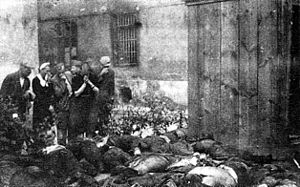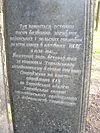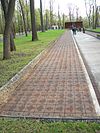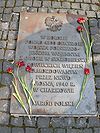- NKVD prisoner massacres
-
The NKVD prisoner massacres were a series of mass executions committed by the Soviet NKVD against prisoners in Eastern Europe, primarily Poland, Ukraine, the Baltic states, Bessarabia and other parts of the Soviet Union from which the Red Army was withdrawing after the German invasion in 1941 (see Operation Barbarossa). Estimates on the death toll vary, from nearly 9000 in all of Ukraine[1] to 100,000,[2] with 10,000 in Western Ukraine alone.[3] Not all prisoners were murdered; some of them were abandoned or managed to escape, because the retreating, panicked Soviet executioners logistically could not kill all of them.[4]
Contents
The massacres
The NKVD and the Red Army killed prisoners in many places from Poland (e.g. Białystok) to Crimea.[5] Immediately after the start of the German invasion of the USSR, the NKVD commenced the execution of large numbers of prisoners in most of their prisons, while the remainder was to be evacuated in death marches.[6][7] Most of them were political prisoners, imprisoned and executed without a trial. The massacres were documented by German authorities and used in anti-Soviet and anti-Jewish propaganda.[8][9][10] With few exceptions, the huge group of prisoners of Western Belarus and Western Ukraine was either marched eastwards, executed, or both.[6] After the war and in recent years, the authorities of Germany, Poland, Belarus, and Israel identified no fewer than 25 prisons whose prisoners were killed—and a much larger number of mass execution sites.[6] Among the notable cases of such mass execution of prisoners were the following:
The hurdles to quality research on the NKVD execution directives, the NKVD chosen centres and timing of executions, or deaths in their custody, and scale of deaths is a task for democratic historians that will take decades to establish since access to data is a sensitive matter.
From a time line perspective, there are distinct periods where the NKVD carried out directives to isolate victims within any given dwelling as well as a wider role in enslaving economic output on a mass scale in important industries (eg gold mining) (1) prior to August 1939, after the Bolsheviks took power (2) during the cosy alliance of the Soviet government with the Chancellor of Germany Adolf Hitler, following the Molotov-Ribbentrop alliance, from late August 1939 through to a little after 22nd June 1941, when Stalin had to eventually acknowledge that Soviet territory was being seized: the alliance was over (3) July 1941 through to April 1945 in the era of the Eastern Front of WWII (4) May 1945 onwards as the NKVD culture evolved under different labels (eg KGB ).
An indication of the scale of deaths or torture commanded by the NKVD, either as executions, or in combination with forced labor camps and gulags needs a literature review section. Nevertheless, a text with a solid thumb nail sketch with valuable documentation can be read in the publication "The Forsaken" by Tim Tzouliadis, which is an award winning book (2009) awarded by Longman-History publishers. For example, even an approximate figure of the human death toll in the secretive Magadan (Siberia) gold mines, across all four time periods is a mystery, where, in block units of 100,000 victims, the analysis is defied by political barriers.
Belarus
- Hrodna (Grodno): on June 22, the NKVD executed several dozen people at the local prison. The mass execution of the remaining 1,700 prisoners was not possible due to the advance of the German army and hurried retreat of the NKVD crew.[11]
- Berezwecz, near Vitebsk[7]: on June 24, the NKVD executed approximately 800 prisoners, most of them Polish citizens. Several thousands more perished during a death march to Nikolaevo near Ulla.[12]
- Chervyen, near Minsk: in late June, the NKVD started the evacuation of all prisons in Minsk. Between June 24 and June 27, several thousand people were killed in Cherven and during the death marches.[13]
- Vileyka (Wilejka): several dozen people, mostly political prisoners, sick and wounded, were executed prior to the departure of the Soviet guards on June 24.[14]
Estonia
- Tartu: on July 9, 1941, almost 250 detainees were shot in Tartu prison and the Gray House courtyard; their bodies were dumped in makeshift graves and in the prison well.[15]
- Kautla massacre: on July 24, 1941 the Red Army killed more than 20 civilians and burnt their farms.
Latvia
- Litene: On June 14, 1941, 120 Latvian Army officers were driven to the woods in the belief they were on a training mission. On arrival they were disarmed, tied up and executed by the NKVD.[16]
Lithuania
- Vilnius: after the German invasion, the NKVD murdered a large number of prisoners of the infamous Lukiškės Prison.[17]
- Rainiai near Telšiai: up to 79 political prisoners were killed in what is called the Rainiai massacre, on June 24 and the following day.
- Pravieniškės prison, near Kaunas: in June 1941, the NKVD murdered 260 political prisoners and all Lithuanian working personnel in the prison.
Poland
By 1941, most of the ethnically Polish population, subject to Soviet rule for two years already, had already been deported off the border regions to remote areas of the Soviet Union. Others, including a large number of Polish civilians of other ethnicities (mostly Belarusians and Ukrainians), were kept in provisional prisons in the towns of the region, where they awaited deportation either to NKVD prisons in Moscow or to the Gulag. It is estimated that out of 13 million people living in the pre-war Eastern Poland, roughly half a million of people were arrested, more than 90% of them being males. Thus approximately every tenth adult male was imprisoned at the time of the German offensive.[6] Many died in prisons from torture or neglect.[6] Methods of torture included scalding victims in boiling water and cutting off ears, noses and fingers.[18] Timothy Snyder estimates that the NKVD shot some 9,817 imprisoned Polish citizens following the German invasion of the USSR in 1941.[19]
Ukraine
- Lviv (Lwów): the massacres in this city began immediately after German attack, on June 22 and continued until June 28. The NKVD executed several thousand inmates in a number of provisional prisons. Among the common methods of extermination were shooting the prisoners in their cells, killing them with grenades thrown into the cells or starving them to death in the cellars. Some were simply bayoneted to death.[2] It is estimated that over 4000 people were murdered that way, while the number of survivors is estimated at ca. 270.[11] The slaughter was briefly terminated when local Ukrainian uprising forced the NKVD to retreat, but then it returned.[20]
- Lutsk (Łuck): After the prison was hit by German bombs, the Soviet authorities promised amnesty to all political prisoners, in order to prevent escapes. As they lined up outside they were machine-gunned by Soviet tanks. They were told: "Those still alive get up." Some 370 stood up and were forced to bury the dead, after which they were murdered as well. The Nazi foreign ministry claimed 1500 Ukrainians were killed while the SS and Nazi military intelligence claimed 4000.[21]
- Berezhany (Brzeżany) near Ternopil (Tarnopol): between June 22 and July 1 the crew of the local NKVD prison has executed without a trial approximately 300 Polish citizens, among them a large number of Ukrainians.[11]
- Vinnitsa: over 9,000 executed.[3]
- Dubno: All the prisoners, including women and children, were executed in Dubno's three-story prison.[2]
- Sambir (Sambor): 570 killed[22]
- Simferopol: on October 31, the NKVD shot a number of people in the NKVD building and in the city prison. In Yalta, on November 4, the NKVD shot all the prisoners in the city prisons.[5]
- Kharkiv 8,000 NKVD inmates along with interned Polish officers were executed on the outskirts of Kharkiv in the area of Piatykhatky, Kharkiv Oblast and buried on the grounds of a NKVD summer hostel.
- Donetsk Rutchenkovo Field
Russia
- Oryol: In September 1941, over 150 political prisoners (among them Christian Rakovsky, Maria Spiridonova and Olga Kameneva) were executed in Medvedevsky Forest near Oryol.
See also
- List of massacres in the Soviet Union
- War crimes
- Mass graves in the Soviet Union
- World War II crimes in Poland
Notes and references
- ^ Harvest of despair, Karel Cornelis Berkhoff
- ^ a b c Robert Gellately. Lenin, Stalin, and Hitler: The Age of Social Catastrophe. Knopf, 2007 ISBN 1400040051 p. 391
- ^ a b (English) Richard Rhodes (2002). Masters of Death: The SS-Einsatzgruppen and the Invention of the Holocaust. New York: Alfred A. Knopf. ISBN 0-375-40900-9. Despite the deportations, Barbarossa surprised the NKVD, whose jails and prisons in the annexed territories were crowded with political prisoners. Rather than releasing their prisoners as they hurriedly retreated during the first week of the war, the Soviet secret police killed them. NKVD prisoner executions in the first week after Barbarossa totaled some ten thousand in western Ukraine and more than nine thousand in Vinnytsia, eastward toward Kiev. Comparable numbers of prisoners were executed in eastern Poland, Byelorussia, Lithuania, Latvia, and Estonia. The Soviet areas had already sustained losses numbering in the hundreds of thousands from the Stalinist purges of 1937-38. “It was not only the numbers of the executed,” historian Yuri Boshyk writes of the evacuation murders, “but also the manner in which they died that shocked the populace. When the families of the arrested rushed to the prisons after the Soviet evacuation, they were aghast to find bodies so badly mutilated that many could not be identified. It was evident that many of the prisoners had also been tortured before death; others were killed en masse.”
- ^ The Greatest Battle By Andrew Nagorski, page 84
- ^ a b Edige Kirimal, "Complete Destruction of National Groups as Groups - The Crimean Turks", from Genocide in the USSR: Studies in Group Destruction (1958), published by the Institute for the Study of the USSR in Munich.
- ^ a b c d e (English) Militargeschichtliches Forschungsamt (corporate author); Gottfried Schramm, Jan T. Gross, Manfred Zeidler et al. (1997). Bernd Wegner. ed. From Peace to War: Germany, Soviet Russia and the World, 1939-1941. Berghahn Books. pp. 47–79. ISBN 1-57181-882-0. http://books.google.com/?id=7odfDAlO64UC&pg=PA77&lpg=PA77&q=Lvov&vq=Lvov&dq=NKVD+1941.
- ^ a b (Polish) Encyklopedia PWN, Zbrodnie Sowickie W Polsce'':After the outbreak of the German-Soviet war, in June 1941, thousands of prisoners have been murdered in mass executions in prisons (among others in Lviv and Berezwecz) and during the evacuation (so-called death marches)
- ^ http://www.zeit.de/2001/26/200126_a-lemberg.xml
- ^ http://www.calvin.edu/academic/cas/gpa/feldpost.htm
- ^ http://www.shtetlinks.jewishgen.org/telz/telz3.html
- ^ a b c (Polish) Anna Gałkiewicz (2001) Informacja o śledztwach prowadzonych w OKŚZpNP w Łodzi w sprawach o zbrodnie popełnione przez funkcjonariuszy sowieckiego aparatu terroru; Biuletyn IPN, Vol. 7 - August 2001
- ^ (Polish) Encyklopedia PWN, BEREZWECZ
- ^ (Polish) Joanna Januszczak Żalbiny w Czerwieni k. Mińska in: Wspólnota Polska monthly
- ^ (Polish) Julian Siedlecki (1990). Losy Polaków w ZSRR w latach 1939-1986. Edward Raczyński (3 ed.). London: Gryf Publications. pp. 59. as cited in: Tadeusz Krahel. "Zginęli w końcu czerwca 1941 roku". Czas Miłosierdzia. http://www.bialystok.opoka.org.pl/czas/arch1/art/kaplani.htm. Retrieved 2006-06-02.
- ^ Steenie Harvey, "The Dark Side of Tartu", at ExpatExchange.com
- ^ Lumans, Valdis O. (2006). Latvia in World War II. Fordham Univ Press. p. 133. ISBN 9780823226276.
- ^ (Polish) Bolesław Paszkowski (2005): Golgota Wschodu
- ^ Paul, Allen. Katyn: Stalin's Massacre and the Seeds of Polish Resurrection. Naval Institute Press, 1996. ISBN 1557506701 p. 155
- ^ Snyder, Timothy. Bloodlands: Europe Between Hitler and Stalin. Basic Books, 2010. ISBN 0465002390 p. 194
- ^ The Greatest Battle By Andrew Nagorski, page 83
- ^ Harvest of despair By Karel Cornelis Berkhoff
- ^ (Polish) Helena Kowalik (November 2004). "Jaki znak twój?". Przegląd 47/2004 (2004–11–15).
Further reading, External links
- Bogdan Musical Konterrevolutionäre Elemente sind zu erschießen. Die Brutalisierung des deutsch-sowjetischen Krieges im Sommer 1941 Berlin Propyläen Verlag 349 S. 2000 ISBN 3-549-07126-4 (in German)
- Soviet Atrocities Committed in Occupied Eastern Poland, June-July 1941
Categories:- History of Poland (1939–1945)
- History of Belarus (1939–1945)
- History of Ukraine
- NKVD
- Soviet World War II crimes
- Political repression in the Soviet Union
- Massacres in Belarus
- Massacres in Poland
- Massacres in Russia
- Massacres in Ukraine
- Massacres in Estonia
- Massacres in Latvia
- Massacres in Lithuania
- People executed by the Soviet Union
- Soviet occupation of Eastern Poland 1939-1941
- Soviet occupation of Bessarabia and Northern Bukovina
- Occupation of the Baltic states
Wikimedia Foundation. 2010.





